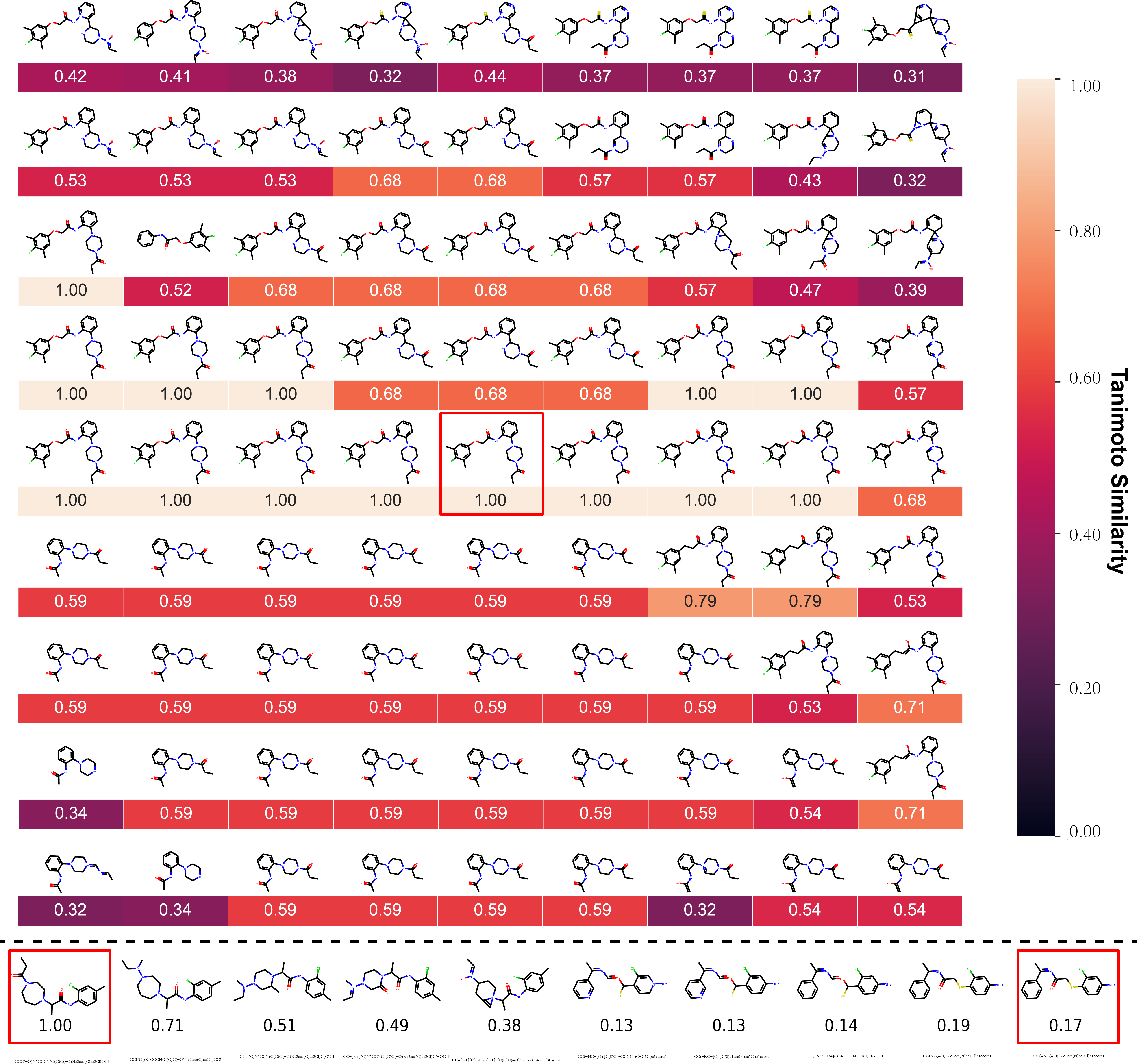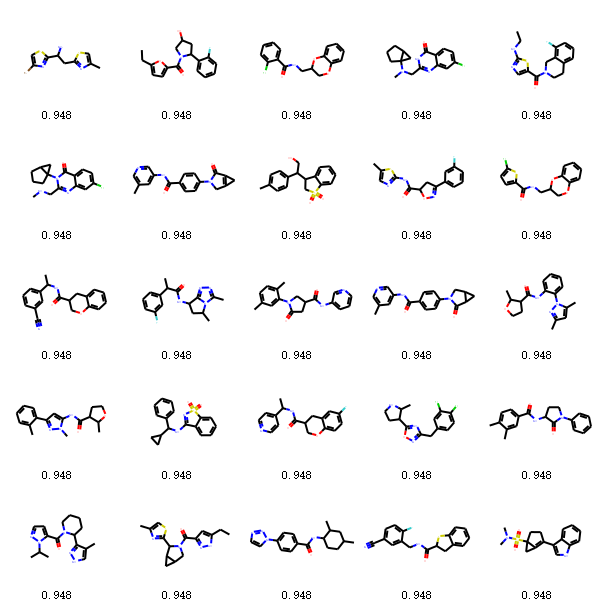Please refer to our paper:
Zang, Chengxi, and Fei Wang. "MoFlow: an invertible flow model for generating molecular graphs." In Proceedings of the 26th ACM SIGKDD International Conference on Knowledge Discovery & Data Mining, pp. 617-626. 2020.
https://arxiv.org/abs/2006.10137
@inproceedings{zang2020moflow,
title={MoFlow: an invertible flow model for generating molecular graphs},
author={Zang, Chengxi and Wang, Fei},
booktitle={Proceedings of the 26th ACM SIGKDD International Conference on Knowledge Discovery \& Data Mining},
pages={617--626},
year={2020}
}
conda create --name moflow python pandas matplotlib (conda 4.6.7, python 3.8.5, pandas 1.1.2, matplotlib 3.3.2)
conda activate moflow
conda install pytorch torchvision cudatoolkit=10.2 -c pytorch (pytorch 1.6.0, torchvision 0.7.0)
conda install rdkit (rdkit 2020.03.6)
conda install orderedset (orderset 2.0.3)
conda install tabulate (tabulate 0.8.7)
conda install networkx (networkx 2.5)
conda install scipy (scipy 1.5.0)
conda install seaborn (seaborn 0.11.0)
pip install cairosvg (cairosvg 2.4.2)
pip install tqdm (tqdm 4.50.0)
To clone code from this project, say
git clone https://github.com/calvin-zcx/moflow.git moflow
To generate molecular graphs from SMILES strings
cd data
python data_preprocess.py --data_name qm9
python data_preprocess.py --data_name zinc250k
cd mflow
python train_model.py --data_name qm9 --batch_size 256 --max_epochs 200 --gpu 0 --debug True --save_dir=results/qm9_64gnn_128-64lin_1-1mask_0d6noise_convlu1 --b_n_flow 10 --b_hidden_ch 128,128 --a_n_flow 27 --a_hidden_gnn 64 --a_hidden_lin 128,64 --mask_row_size_list 1 --mask_row_stride_list 1 --noise_scale 0.6 --b_conv_lu 1 2>&1 | tee qm9_64gnn_128-64lin_1-1mask_0d6noise_convlu1.log
cd mflow
python train_model.py --data_name zinc250k --batch_size 256 --max_epochs 200 --gpu 0 --debug True --save_dir=results/zinc250k_512t2cnn_256gnn_512-64lin_10flow_19fold_convlu2_38af-1-1mask --b_n_flow 10 --b_hidden_ch 512,512 --a_n_flow 38 --a_hidden_gnn 256 --a_hidden_lin 512,64 --mask_row_size_list 1 --mask_row_stride_list 1 --noise_scale 0.6 --b_conv_lu 2 2>&1 | tee zinc250k_512t2cnn_256gnn_512-64lin_10flow_19fold_convlu2_38af-1-1mask.log
https://drive.google.com/drive/folders/1runxQnF3K_VzzJeWQZUH8VRazAGjZFNF
cd mflow
python generate.py --model_dir results/qm9_64gnn_128-64lin_1-1mask_0d6noise_convlu1 -snapshot model_snapshot_epoch_200 --gpu 0 --data_name qm9 --hyperparams-path moflow-params.json --batch-size 256 --reconstruct 2>&1 | tee qm9_reconstruct_results.txt
### Results
Tips: results can be printed & dumped to a .txt file by "2>&1 | tee qm9_reconstruct_results.txt"
133885 in total, 120803 training data, 13082 testing data, 256 batchsize, train/batchsize 471.88671875
...
iter/total: 468/472, reconstruction_rate:1.0
iter/total: 469/472, reconstruction_rate:1.0
iter/total: 470/472, reconstruction_rate:1.0
iter/total: 471/472, reconstruction_rate:1.0
reconstruction_rate for all the train data:1.0 in 120803
Invertible model! 100% reconstruction!
cd mflow
python generate.py --model_dir results/zinc250k_512t2cnn_256gnn_512-64lin_10flow_19fold_convlu2_38af-1-1mask -snapshot model_snapshot_epoch_200 --gpu 0 --data_name zinc250k --hyperparams-path moflow-params.json --batch-size 256 --reconstruct 2>&1 | tee zinc250k_reconstruct_results.txt
249455 in total, 224568 training data, 24887 testing data, 256 batchsize, train/batchsize 877.21875
...
iter/total: 877/878, reconstruction_rate:1.0
reconstruction_rate for all the train data:1.0 in 224568
Invertible model! 100% reconstruction!
10000 samples * 5 times:
python generate.py --model_dir results/qm9_64gnn_128-64lin_1-1mask_0d6noise_convlu1 -snapshot model_snapshot_epoch_200 --gpu 0 --data_name qm9 --hyperparams-path moflow-params.json --batch-size 10000 --temperature 0.85 --delta 0.05 --n_experiments 5 --save_fig false --correct_validity true 2>&1 | tee qm9_random_generation.log
validity: mean=100.00%, sd=0.00%, vals=[100.0, 100.0, 100.0, 100.0, 100.0]
novelty: mean=98.05%, sd=0.12%, vals=[98.07731024763439, 98.11472930738985, 97.88434414668548, 97.95239055880573, 98.21877830331086]
uniqueness: mean=99.26%, sd=0.09%, vals=[99.33999999999999, 99.19, 99.26, 99.14, 99.37]
abs_novelty: mean=97.32%, sd=0.18%, vals=[97.43, 97.32, 97.16, 97.11, 97.6]
abs_uniqueness: mean=99.26%, sd=0.09%, vals=[99.33999999999999, 99.19, 99.26, 99.14, 99.37]
Task random generation done! Time 185.09 seconds, Data: Tue Sep 29 11:20:15 2020
# Above is just one random result. Tuning:
--batch-size for the number of mols to be generated
--temperature for different generation results,
--correct_validity false for results without correction
--save_fig true for figures of generated mols, set batch-size a resoanble number for dump figures
# more details see parameter configuration in generate.py
# Output details are in qm9_random_generation.log
10000 samples * 5 times:
python generate.py --model_dir results/zinc250k_512t2cnn_256gnn_512-64lin_10flow_19fold_convlu2_38af-1-1mask -snapshot model_snapshot_epoch_200 --gpu 0 --data_name zinc250k --hyperparams-path moflow-params.json --temperature 0.85 --batch-size 10000 --n_experiments 5 --save_fig false --correct_validity true 2>&1 | tee zinc250k_random_generation.log
validity: mean=100.00%, sd=0.00%, vals=[100.0, 100.0, 99.99, 100.0, 100.0]
novelty: mean=100.00%, sd=0.00%, vals=[100.0, 100.0, 100.0, 100.0, 100.0]
uniqueness: mean=99.99%, sd=0.01%, vals=[100.0, 99.98, 100.0, 99.99, 99.99]
abs_novelty: mean=99.99%, sd=0.01%, vals=[100.0, 99.98, 99.99, 99.99, 99.99]
abs_uniqueness: mean=99.99%, sd=0.01%, vals=[100.0, 99.98, 99.99, 99.99, 99.99]
Task1 random generation done! Time 537.13 seconds, Data: Tue Sep 29 11:36:12 2020
# Above is just one random result. Tuning:
--batch-size for the number of mols to be generated
--temperature for different generation results,
--correct_validity false for results without correction
--save_fig true for figures of generated mols, set batch-size a resoanble number for dump figures
# more details see parameter configuration in generate.py
# Output details are in qm9_random_generation.log
interpolation between 2 molecules (molecular graphs)
python generate.py --model_dir results/qm9_64gnn_128-64lin_1-1mask_0d6noise_convlu1 -snapshot model_snapshot_epoch_200 --gpu 0 --data_name qm9 --hyperparams-path moflow-params.json --batch-size 1000 --temperature 0.65 --int2point --inter_times 50 --correct_validity true 2>&1 | tee qm9_visualization_int2point.log
interpolation in a grid of molecules (molecular graphs)
python generate.py --model_dir results/qm9_64gnn_128-64lin_1-1mask_0d6noise_convlu1 -snapshot model_snapshot_epoch_200 --gpu 0 --data_name qm9 --hyperparams-path moflow-params.json --batch-size 1000 --temperature 0.65 --delta 5 --intgrid --inter_times 40 --correct_validity true 2>&1 | tee tee qm9_visualization_intgrid.log
interpolation between 2 molecules (molecular graphs)
python generate.py --model_dir results/zinc250k_512t2cnn_256gnn_512-64lin_10flow_19fold_convlu2_38af-1-1mask -snapshot model_snapshot_epoch_200 --gpu 0 --data_name zinc250k --hyperparams-path moflow-params.json --batch-size 1000 --temperature 0.8 --delta 0.5 --n_experiments 0 --correct_validity true --int2point --inter_times 10 2>&1 | tee zinc250k_visualization_int2point.log
interpolation in a grid of molecules (molecular graphs)
python generate.py --model_dir results/zinc250k_512t2cnn_256gnn_512-64lin_10flow_19fold_convlu2_38af-1-1mask -snapshot model_snapshot_epoch_200 --gpu 0 --data_name zinc250k --hyperparams-path moflow-params.json --batch-size 1000 --temperature 0.8 --delta 5 --n_experiments 0 --correct_validity true --intgrid --inter_times 2 2>&1 | tee zinc250k_visualization_intgrid.log
python optimize_property.py -snapshot model_snapshot_epoch_200 --hyperparams_path moflow-params.json --batch_size 256 --model_dir results/zinc250k_512t2cnn_256gnn_512-64lin_10flow_19fold_convlu2_38af-1-1mask --gpu 0 --max_epochs 3 --weight_decay 1e-3 --data_name zinc250k --hidden 16, --temperature 1.0 --property_name qed 2>&1 | tee training_optimize_zinc250k_qed.log
# Output: a molecular property prediction model for optimization, say named as qed_model.pt
# e.g. saving qed regression model to: results/zinc250k_512t2cnn_256gnn_512-64lin_10flow_19fold_convlu2_38af-1-1mask/qed_model.pt
# Train and save model done! Time 477.87 seconds
# Can tune:
# --max_epochs 3
# --weight_decay 1e-3
# --hidden 16
# etc.
https://drive.google.com/drive/folders/1runxQnF3K_VzzJeWQZUH8VRazAGjZFNF
python optimize_property.py -snapshot model_snapshot_epoch_200 --hyperparams_path moflow-params.json --batch_size 256 --model_dir results/zinc250k_512t2cnn_256gnn_512-64lin_10flow_19fold_convlu2_38af-1-1mask --gpu 0 --data_name zinc250k --property_name qed --topk 2000 --property_model_path qed_model.pt --debug false --topscore 2>&1 | tee zinc250k_top_qed_optimized.log
# Input: --property_model_path qed_model.pt is the regression model
# Output: dump a ranked list of generated optimized and novel molecules w.r.t qed
python optimize_property.py -snapshot model_snapshot_epoch_200 --hyperparams_path moflow-params.json --batch_size 256 --model_dir results/zinc250k_512t2cnn_256gnn_512-64lin_10flow_19fold_convlu2_38af-1-1mask --gpu 0 --max_epochs 3 --weight_decay 1e-2 --data_name zinc250k --hidden 16, --temperature 1.0 --property_name plogp 2>&1 | tee training_optimize_zinc250k_plogp.log
# Output: a molecular property prediction model for optimization, say named as plogp_model.pt
# e.g. saving plogp regression model to: results/zinc250k_512t2cnn_256gnn_512-64lin_10flow_19fold_convlu2_38af-1-1mask/plogp_model.pt
# Train and save model done! Time 473.74 seconds
# Can tune:
# --max_epochs 3
# --weight_decay 1e-2
# --hidden 16
#etc.
To optimize existing molecules to get novel molecules with optimized plogp scores and constrained similarity
python optimize_property.py -snapshot model_snapshot_epoch_200 --hyperparams_path moflow-params.json --batch_size 256 --model_dir results/zinc250k_512t2cnn_256gnn_512-64lin_10flow_19fold_convlu2_38af-1-1mask --gpu 0 --data_name zinc250k --property_name plogp --topk 800 --property_model_path qed_model.pt --consopt --sim_cutoff 0 2>&1 | tee zinc250k_constrain_optimize_plogp.log
# Input: --property_model_path qed_model.pt or plogp_model.pt is the regression model
--sim_cutoff 0 (or 0.2, 0.4 etc for similarity)
--topk 800 (choose first 800 molecules with worset property values for improving)
# Output:
# Using qed_model.pt for optimizing plogp with
# Because qed and plogp have some correlations, here we use both qed/plogp model for 2 optimization tasks
# --sim_cutoff 0:
# similarity: 0.300610 +/- 0.201674
# Improvement: 8.612461 +/- 5.436995
# success rate: 0.98875
# --sim_cutoff 0.2:
# similarity: 0.434700 +/- 0.196490
# Improvement: 7.057115 +/- 5.041250
# success rate: 0.9675
# --sim_cutoff 0.4:
# similarity: 0.608440 +/- 0.177670
# Improvement: 4.712418 +/- 4.549682
# success rate: 0.8575
# --sim_cutoff 0.6:
# similarity: 0.792550 +/- 0.144577
# Improvement: 2.095266 +/- 2.858545
# success rate: 0.5825
# Using plogp_model.pt for optimizing plogp with
# --sim_cutoff 0:
# similarity: 0.260503 +/- 0.195945
# Improvement: 9.238813 +/- 6.279859
# success rate: 0.9925
# --sim_cutoff 0.2:
# similarity: 0.425541 +/- 0.198020
# Improvement: 7.246221 +/- 5.325543
# success rate: 0.9575
# --sim_cutoff 0.4:
# similarity: 0.625976 +/- 0.189293
# Improvement: 4.504411 +/- 4.712031
# success rate: 0.8425
# --sim_cutoff 0.6:
# similarity: 0.810805 +/- 0.146080
# Improvement: 1.820525 +/- 2.595302
# success rate: 0.565
More configurations please refer to our codes optimize_property.py and the optimization chapter in our paper.



